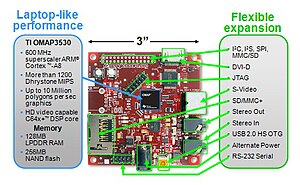BeagleBoard
This article's lead section may be too short to adequately summarize the key points. (February 2010) |

The Beagle Board is a low-power, low-cost Single-board computer produced by Texas Instruments in association with Digi-Key. The Beagle Board was designed with open source development in mind, and as a way of demonstrating the Texas Instrument's OMAP3530 system-on-a-chip. The board was developed by a small team of TI engineers.[1]
Features
The Beagle Board measures approximately 3" by 3" and has all the functionality of a basic computer. The OMAP3530 includes an ARM Cortex-A8 CPU (which can run Windows CE, Linux or Symbian), a TMS320C64x+ DSP for accelerated video and audio decoding, and an Imagination Technologies PowerVR SGX530 GPU to provide accelerated 2D and 3D rendering that supports OpenGL ES 2.0. Video out is provided through separate S-Video and HDMI connections. A single SD/MMC card slot supporting SDIO, a USB On-the-Go port, an RS-232 serial connection, a JTAG connection, and two stereo 3.5mm jacks for audio in/out are provided.
Built-in storage and memory are provided through a PoP chip that includes 256MB of NAND flash memory and 256MB of RAM (128MB on earlier models).
The board uses up to 2W of power and can be powered from the USB connector, or a separate 5v power supply. Because of the low power consumption, no additional cooling is required.
A Beagle board XM is planned and expected by June 2010. The XM will have a faster CPU core and a few added peripherals[2].
Rev. C4 Specifications

- Package on Package POP CPU/Memory chip.
- Peripheral connections[4]
- DVI-D (HDMI connector chosen for size - maximum resolution is 1280x1024) , S-Video, USB OTG (mini AB), USB, SD/MMC card slot
- Stereo in and out jacks
- RS232 port
- JTAG connector
- Power socket (5V barrel connector type)
- Development[5]
- Boot code stored in ROM
- Boot from NAND memory, SD/MMC, USB, or Serial
- Alternative Boot source button.
- Has been demonstrated using Android[6], Angstrom Linux[7], Ubuntu, Gentoo[8] and Maemo Linux distributions[9], the Win CE operating system[10] and a development version of RISC OS 5[11][12][13][14][15].
Optional Boards
- BeagleBoard Zippy - Feature Expander daughter Card for Beagle Board
- BeagleBoard Zippy2 - 2nd generation Zippy. (UART, EEPROM, 100BASE-T, SD-Slot, RTC, I2C(5V))
- BeagleLCD2 Expansion Board - 4.3" Wide Aspect LCD Panel + Touchscreen with Interface Board. Developed by HY Research.
Optional Enclosures
- BeagleBoard RevC Clear Acrylic Case - Just fitted case for a BeagleBoaed alone. (W/O Zippy2)
- BeagleLCD2 Clear Acrylic Case - Just fitted case for BeagleBoaed with BeagleLCD2
Clones
- IGEPv2 - a slightly larger board that includes more RAM, built-in Bluetooth and Wi-Fi, a USB host, and an Ethernet jack
- EBVBeagle Board - Beagle Board clone from EBV Elektronik
- ICETEK Mini Board (Chinese)[16]
- DevKit8000 (Chinese)[17]
Similar products
- BeagleBoard xM A successor of BeagleBoard. (1GHz DM3730, 512MB RAM)
- Hawk Board Low Power OMAP SBC with SATA & VGA out.
- Pandora handheld game console that uses the same Texas Instruments OMAP3530 as the BeagleBoard.
- Gumstix Overo COMs use the OMAP3503 or the OMAP3530 to provide a full product line of Beagleboard-compatible products for hobbyist, robotic and commercial use.
- OSWALD - developed by Oregon State University students for computer science education, uses the OMAP3530.
- Empower Technologies's EMP3503 and EMP3530 single-board computers running LEOs (RTOS)[18]
See also
References
- ^ a b http://linuxdevices.com/news/NS5852740920.html
- ^ http://groups.google.com/group/beagleboard/msg/609bba9be3422b1d
- ^ a b c ""OMAP3530 Beagle Board" ''High performance and numerous expansion options'':page 3". Dkc1.digikey.com. 2009-05-27. Retrieved 2010-02-04.
- ^ ""OMAP3530 Beagle Board" ''High performance and numerous expansion options'':page 4". Dkc1.digikey.com. 2009-05-27. Retrieved 2010-02-04.
- ^ ""OMAP3530 Beagle Board" ''Boot Options'': page 9". Dkc1.digikey.com. 2009-05-27. Retrieved 2010-02-04.
- ^ "Android On Beagle". Beagleboard.org. Retrieved 2010-02-04.
- ^ http://www.linuxdevices.com/news/NS8479495970.html
- ^ "Neuvoo Project". Neuvoo. Neuvoo Devs. Retrieved 2010-01-05.
- ^ Paul, Ryan (2008-08-01). "TI launches hackable Beagle Board for hobbyist projects". Arstechnica.com. Retrieved 2010-02-04.
- ^ http://www.windowsfordevices.com/news/NS5111878566.html
- ^ "RISC OS Open Cortex-A8 port". Riscosopen.org. 2010-01-18. Retrieved 2010-02-04.
- ^ "RISC OS 5 pictured running on ARM Cortex-A8 kit". Drobe.co.uk. Retrieved 2010-02-04.
- ^ "Beagleboard runs RISC OS 5 desktop". Drobe.co.uk. Retrieved 2010-02-04.
- ^ "RISC OS on OMAP - the future?". Iconbar.com. Retrieved 2010-02-04.
- ^ [1] RISC OS on new hardware
- ^ "Mini Board". eLinux.org. Retrieved 2010-02-04.
- ^ "DevKit8000". eLinux.org. Retrieved 2010-02-04.
- ^ http://www.linuxfordevices.com/c/a/News/Empower-EMP3503-and-EMP3530/
External links
- Beagleboard.org
- OMAP35x Applications Processors
- Texas Instruments OMAP Developer Network
- Google Code hosted Beagle Board code site
- elinux.org BeagleBoard wiki page
- Link to set of Beagle Board introductory videos (Youtube)
- PEEDI JTAG/BDM Emulator and Flash Programmer
